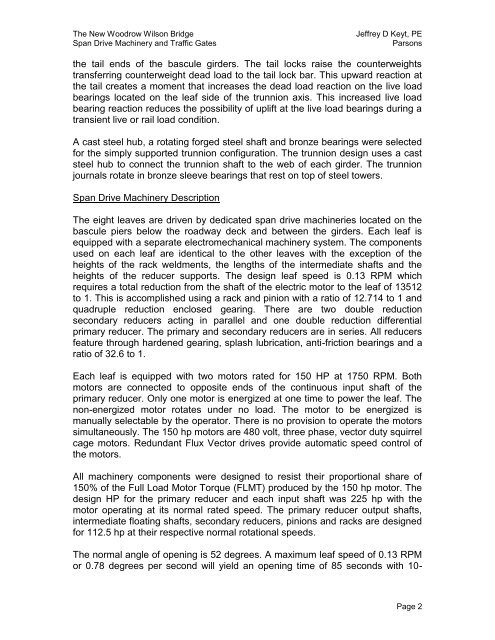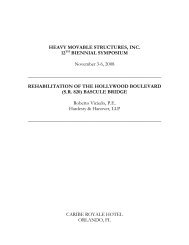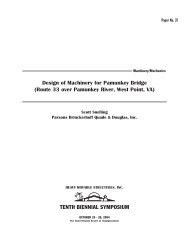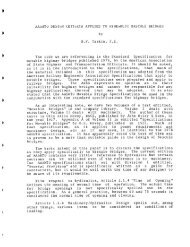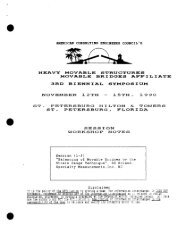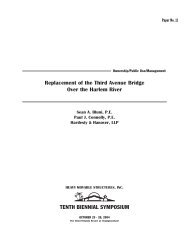The New Woodrow Wilson Bridge - Heavy Movable Structures, Inc.
The New Woodrow Wilson Bridge - Heavy Movable Structures, Inc.
The New Woodrow Wilson Bridge - Heavy Movable Structures, Inc.
Create successful ePaper yourself
Turn your PDF publications into a flip-book with our unique Google optimized e-Paper software.
<strong>The</strong> <strong>New</strong> <strong>Woodrow</strong> <strong>Wilson</strong> <strong>Bridge</strong>Span Drive Machinery and Traffic GatesJeffrey D Keyt, PEParsonsthe tail ends of the bascule girders. <strong>The</strong> tail locks raise the counterweightstransferring counterweight dead load to the tail lock bar. This upward reaction atthe tail creates a moment that increases the dead load reaction on the live loadbearings located on the leaf side of the trunnion axis. This increased live loadbearing reaction reduces the possibility of uplift at the live load bearings during atransient live or rail load condition.A cast steel hub, a rotating forged steel shaft and bronze bearings were selectedfor the simply supported trunnion configuration. <strong>The</strong> trunnion design uses a caststeel hub to connect the trunnion shaft to the web of each girder. <strong>The</strong> trunnionjournals rotate in bronze sleeve bearings that rest on top of steel towers.Span Drive Machinery Description<strong>The</strong> eight leaves are driven by dedicated span drive machineries located on thebascule piers below the roadway deck and between the girders. Each leaf isequipped with a separate electromechanical machinery system. <strong>The</strong> componentsused on each leaf are identical to the other leaves with the exception of theheights of the rack weldments, the lengths of the intermediate shafts and theheights of the reducer supports. <strong>The</strong> design leaf speed is 0.13 RPM whichrequires a total reduction from the shaft of the electric motor to the leaf of 13512to 1. This is accomplished using a rack and pinion with a ratio of 12.714 to 1 andquadruple reduction enclosed gearing. <strong>The</strong>re are two double reductionsecondary reducers acting in parallel and one double reduction differentialprimary reducer. <strong>The</strong> primary and secondary reducers are in series. All reducersfeature through hardened gearing, splash lubrication, anti-friction bearings and aratio of 32.6 to 1.Each leaf is equipped with two motors rated for 150 HP at 1750 RPM. Bothmotors are connected to opposite ends of the continuous input shaft of theprimary reducer. Only one motor is energized at one time to power the leaf. <strong>The</strong>non-energized motor rotates under no load. <strong>The</strong> motor to be energized ismanually selectable by the operator. <strong>The</strong>re is no provision to operate the motorssimultaneously. <strong>The</strong> 150 hp motors are 480 volt, three phase, vector duty squirrelcage motors. Redundant Flux Vector drives provide automatic speed control ofthe motors.All machinery components were designed to resist their proportional share of150% of the Full Load Motor Torque (FLMT) produced by the 150 hp motor. <strong>The</strong>design HP for the primary reducer and each input shaft was 225 hp with themotor operating at its normal rated speed. <strong>The</strong> primary reducer output shafts,intermediate floating shafts, secondary reducers, pinions and racks are designedfor 112.5 hp at their respective normal rotational speeds.<strong>The</strong> normal angle of opening is 52 degrees. A maximum leaf speed of 0.13 RPMor 0.78 degrees per second will yield an opening time of 85 seconds with 10-Page 2


